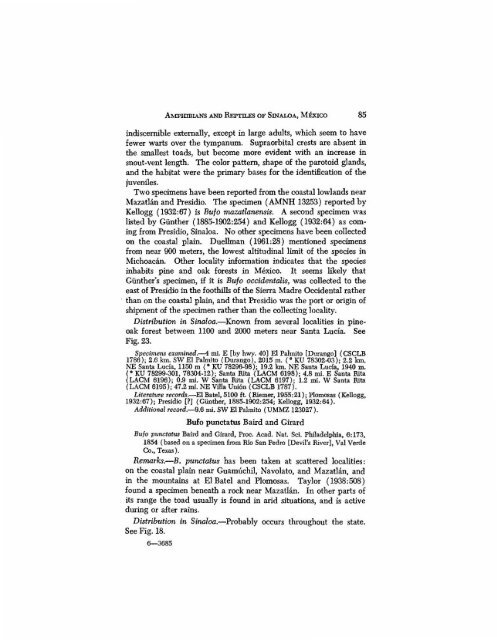The Amphibians and Reptiles of Sinaloa, Mexico - Smithsonian ...
The Amphibians and Reptiles of Sinaloa, Mexico - Smithsonian ...
The Amphibians and Reptiles of Sinaloa, Mexico - Smithsonian ...
You also want an ePaper? Increase the reach of your titles
YUMPU automatically turns print PDFs into web optimized ePapers that Google loves.
AMPHIBIANS AND REPTILES OF SINALOA, MEXICO 85<br />
indiscernible externally, except in large adults, which seem to have<br />
fewer warts over the tympanum. Supraorbital crests are absent in<br />
the smallest toads, but become more evident with an increase in<br />
snout-vent length. <strong>The</strong> color pattern, shape <strong>of</strong> the parotoid gl<strong>and</strong>s,<br />
<strong>and</strong> the habitat were the primary bases for the identification <strong>of</strong> the<br />
juveniles.<br />
Two specimens have been reported from the coastal lowl<strong>and</strong>s near<br />
Mazatlan <strong>and</strong> Presidio. <strong>The</strong> specimen (AMNH 13253) reported by<br />
Kellogg (1932:67) is Bufo mazailanensis. A second specimen was<br />
listed by Giinther (1885-1902:254) <strong>and</strong> Kellogg (1932:64) as coming<br />
from Presidio, <strong>Sinaloa</strong>. No other specimens have been collected<br />
on the coastal plain. Duellman (1961:28) mentioned specimens<br />
from near 900 meters, the lowest altitudinal limit <strong>of</strong> the species in<br />
Michoacan. Other locality information indicates that the species<br />
inhabits pine <strong>and</strong> oak forests in <strong>Mexico</strong>. It seems likely that<br />
Giinther's specimen, if it is Bufo occidentalis, was collected to the<br />
east <strong>of</strong> Presidio in the foothills <strong>of</strong> the Sierra Madre Occidental rather<br />
than on the coastal plain, <strong>and</strong> that Presidio was the port or origin <strong>of</strong><br />
shipment <strong>of</strong> the specimen rather than the collecting locality.<br />
Distribution in <strong>Sinaloa</strong>.—Known from several localities in pineoak<br />
forest between 1100 <strong>and</strong> 2000 meters near Santa Lucia. See<br />
Fig. 23.<br />
Specimen! examined.—4 mi. E [by hwy. 40] El Palmito [Durango] (CSCLB<br />
1786); 2.6 km. SW El Palmito (Durango), 2015 m. ('KU 78302-03); 2.2 km.<br />
NE Santa Lucia, 1150 m (• KU 78296-98); 19.2 km. NE Santa Lucia, 1940 m.<br />
(• KU 78299-301, 78304-12); Santa Rita (LACM 6198); 4.8 mi. E Santa Rita<br />
(LACM 6196); 0,9 mi. W Santa Rita (LACM 6197); 1.2 mi. W Santa Rita<br />
(LACM 6195); 47.2 mi. NE Villa Union (CSCLB 1787).<br />
Literature records.—El Bate], 5100 ft. (Riemer, 1955:21); plomosas (Kellogg,<br />
1932:67); Presidio [?J (Giinther, 1885-1902:254; Kellogg, 1932:64).<br />
Additional record.—9.6 mi. SWE1 Palmito (UMMZ 123027).<br />
Bufo punctatus Baird <strong>and</strong> Guard<br />
Bufo punctatus Baird <strong>and</strong> Girard, Proc. Acad. Nat. Sci. Philadelphia, 6:173,<br />
1854 (based on a specimen from Rio San Pedro [Devil's River], Val Verde<br />
Co., Texas).<br />
Remarks.—B. punctatus has been taken at scattered localities:<br />
on the coastal plain near Guamuchil, Navolato, <strong>and</strong> Mazatlan, <strong>and</strong><br />
in the mountains at El Batel <strong>and</strong> Plomosas. Taylor (1938:508)<br />
found a specimen beneath a rock near Mazatlan. In other parts <strong>of</strong><br />
its range the toad usually is found in arid situations, <strong>and</strong> is active<br />
during or after rains.<br />
Distribution in <strong>Sinaloa</strong>.—Probably occurs throughout the state.<br />
See Fig. 18.<br />
6—3685
















